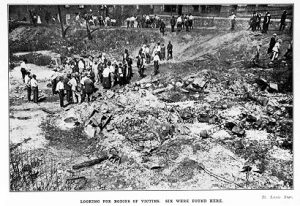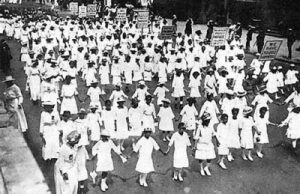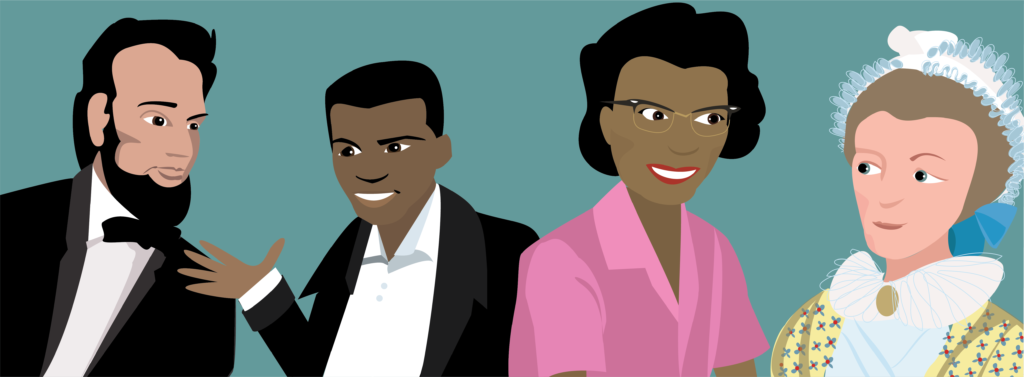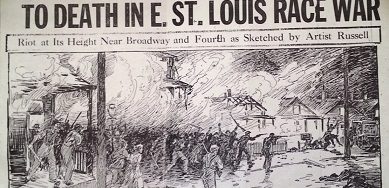
The history of the 1917 East St. Louis Race Riot intersects many themes. The Great War put an abrupt halt to immigrant labor from Europe while creating a new demand for African-American workers in America’s northern manufacturing cities.
War in Europe brings opportunity and conflict at home
First thousands and then tens of thousands of African-Americans left the sharecropper fields of the Jim Crow South for significantly better-paying jobs – and less discrimination – available in cities such as Detroit, St. Louis, Gary, and Philadelphia.
At the same time, the highly segregated American labor movement was on the ropes, business giants having gained the upper hand politically in the 1890s. Factory owners took full advantage of the circumstances, replacing white workers with eager blacks newly arrived from the South.
Big-city political machines also saw the wave of migrating African-Americans as a threat to their power and so used racial prejudice to stoke resentment among workers.
Background to a massacre
 Follow heightened racial tensions in St. Louis during the last part of May, black residents of East St. Louis, (Illinois), were fired upon by whites in a black Model-T Ford, then nearly ubiquitous. Later that day, July 1, a similar Model-T with white men was mistaken for the shooters. Two white police officers investigating the earlier gunfire were mistakenly gunned down by residents of the African-American section of East St. Louis. Word of the killings spread and three days of violence began, claiming at least 39 African Americans, though contemporary accounts put the toll as at least 100.
Follow heightened racial tensions in St. Louis during the last part of May, black residents of East St. Louis, (Illinois), were fired upon by whites in a black Model-T Ford, then nearly ubiquitous. Later that day, July 1, a similar Model-T with white men was mistaken for the shooters. Two white police officers investigating the earlier gunfire were mistakenly gunned down by residents of the African-American section of East St. Louis. Word of the killings spread and three days of violence began, claiming at least 39 African Americans, though contemporary accounts put the toll as at least 100.It is estimated that between 1,000 to 3,000 whites crossed the bridge linking St. Louis, Missouri with East St. Louis and began hunting African-Americans. Many blacks fled the Illinois side, escaping across the bridge to the relative safety of the St. Louis. After the bridge was closed, however, some attempted to cross the nearly half-mile-wide Mississippi River which claimed lives to drowning.
Accounts of the time depict a police response that ranged from indifference to actual participation in hunting down African-Americans as an adjunct of the white mobs. On July 3, Illinois Militia, (forerunner of the National Guard), arrived in East St. Louis. Again, many of the all-white troops were reported to have joined in the carnage at first.
When order was more-or-less restored after three days of murder and destruction of black-owned businesses, many by fire, (the mob’s first act was to cut off access to water meant to fight fires), bodies of the dead littered the streets of East St. Louis.
Formal pleas to President Woodrow Wilson, asking for a formal investigation of the riot were met with claims that not enough evidence warranted an official response. In October, a trial was held in Illinois for twenty-five blacks and ten whites on charges ranging from murder to inciting a riot.
Silent responses
 Most notable was the response from the New York City chapter of the nascent organization, the National Association for the Advancement of Colored People, formed less than a decade earlier in response to racial violence in Springfield, Illinois. More than ten thousand people participated in a Silent March through the city, drawing attention to the Wilson Administration’s failure to investigate the recent violence.
Most notable was the response from the New York City chapter of the nascent organization, the National Association for the Advancement of Colored People, formed less than a decade earlier in response to racial violence in Springfield, Illinois. More than ten thousand people participated in a Silent March through the city, drawing attention to the Wilson Administration’s failure to investigate the recent violence.In spite of widespread condemnation of the wanton violence in East St. Louis, the next decade saw even more gruesome acts of racial violence, both large-scale and small against African-Americans. And until recently, the names of those pograms, (36 alone in 1919), Chicago, Elaine, Rosewood, Ocoee, and Washington, D.C., among many others, remained largely unknown, mostly untaught even at the post-secondary level.

